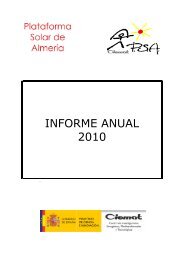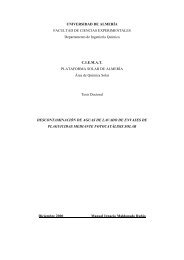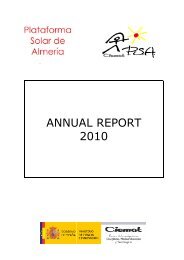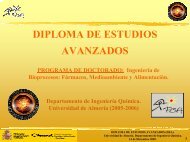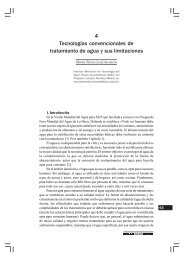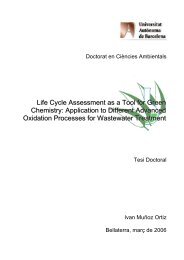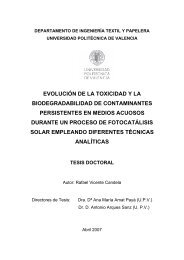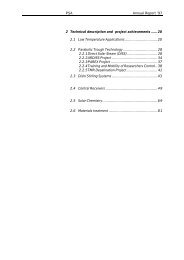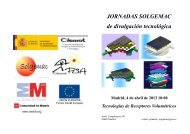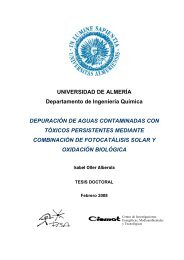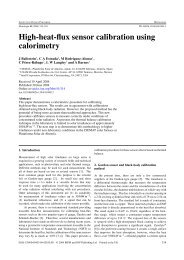Annual Report 2006 - Plataforma Solar de AlmerÃa
Annual Report 2006 - Plataforma Solar de AlmerÃa
Annual Report 2006 - Plataforma Solar de AlmerÃa
Create successful ePaper yourself
Turn your PDF publications into a flip-book with our unique Google optimized e-Paper software.
FACILITIES AND INSTALLATIONS<br />
2.5.5 Test Table<br />
This mobile support is located un<strong>de</strong>r the focus of the concentrator. It<br />
moves on three axes (X, Y, Z) perpendicular to each other and positions the<br />
test sample with great precision in the focal area.<br />
2.5.6 Distribution of the Flux Density in the Focus<br />
The concentration and distribution of the flux <strong>de</strong>nsity in the focus characterize<br />
a solar furnace. This distribution usually has a Gaussian geometry and<br />
is characterized by a CCD camera hooked up to an image processor and a<br />
lambertian target. The characteristics of the focus with 100% aperture and<br />
solar radiation of 1000 W/m 2 are: peak flux, 3000 kW/m 2 , total power, 58 kW<br />
and focal diameter, 23 cm [Neumann, 1994].<br />
2.6 <strong>Solar</strong> Photochemical Facilities<br />
The PTC (Parabolic-<br />
Trough Collector) photochemical<br />
pilot plant is<br />
presently configured in<br />
four 128-m 2 parabolictrough<br />
solar collectors with<br />
two-axis solar tracking and<br />
a concentration factor of<br />
10.5 suns. The 56-mmdiameter<br />
absorber tube is<br />
ma<strong>de</strong> of 2-mm-thick borosilicate<br />
glass.<br />
There are several CPC<br />
plants installed at the PSA.<br />
The ol<strong>de</strong>st (1994) consists<br />
of three 3-m 2 modules<br />
tilted 37º from the horizon.<br />
The total system volume is<br />
Figure 2.1<br />
about 250 L and the absorber tube holds 108 L (illuminated volume). In 2002,<br />
a new 15-m 2 collector for experiments of up to 300 L was installed. It also has<br />
small twin 3.08-m 2 prototypes with a 40-L total volume, 22 L of which is irradiated,<br />
for parallel experiments. Since 2004, a new CPC system, with 50-mmdiameter<br />
photoreactor, more suitable for photo-Fenton applications, with tank<br />
and recirculation pump (75 L), has been hooked up to a 150-L biological reactor<br />
based on fixed biomass on an inert matrix, and 50-L ozonization system<br />
with ozone production of up to 15 g O 3 /h. All of it is monitored (pH, T, ORP,<br />
O 2 , flow rate, H 2 O 2 ,0 3 ) by computer. Furthermore, there are also several prototypes<br />
for water disinfection applications (Figure 2.1). There are also three<br />
ultraviolet and two global solar radiation measurement sensors placed horizontally<br />
and tilted 37º (the same angle as the CPCs) to the Earth’s surface. All<br />
of the data are sent to a computer that stores them for later evaluation of<br />
results.<br />
2.7 PSA Analysis Lab<br />
Partial view of the solar<br />
photochemical facilities. Front of<br />
solar CPC collector prototype used<br />
for water disinfection.<br />
The PSA solar chemistry lab is a 75-M 2 building <strong>de</strong>signed to contain all of the<br />
conventional laboratory equipment: work benches, gas extraction hood, storage<br />
space for small amounts of chemicals, centralized gas distribution system,<br />
UPS, safety systems (extinguishers, shower, eyewash, etc.) precision<br />
25



